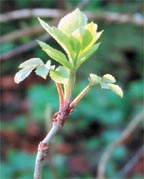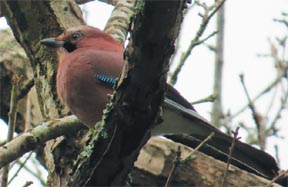|
Wildlife
Newsletter for the Township of Dalkey February 2015 - Michael Ryan |
 Elder Bush unseasonal growth |
Last
year hadn’t even ended when there were all sorts of unseasonable
things happening due to the mild weather and possibly due to the effects
of last year’s warm summer. There were new green leaves opening
on elder bushes on Dalkey Hill before the end of December, wild cranesbills
were in flower over Dalkey quarry and of course the gorse was in bloom
over the Vico. Early flowering and growth has now become such a regular
occurrence that there is now an annual count done in Britain and Ireland
on the first day of the year with amateur and professional botanists
going out to record what native wild plants were found in flower. This
year 368 different species of native plants were found in flower in
Britain and Ireland, many four or five months before they would traditionally
have bloomed. One of many interesting reports from Ireland during the
count was of a Strawberry Tree (Arbutus Unedo), one of Ireland’s
few unique indigenous trees, being in flower near Muckross in Kerry.
The total number counted doesn’t include flowering garden plants
which would probably have exceeded that number, the white tips of snowdrops
were already peeping above the ground on our lawn on Christmas day. |
|
|
In February you tend to get that crossover when some resident
birds are already planning to nest while birds that have come here
for the winter are still arriving in gardens. Last year in early February
a lovely male goldfinch was declaring his territory by singing gloriously
from the path above the Vico Road while within the same week we had
our first ever brambling, a Northern European finch who move south
during the winter, coming to feed on our sunflower seeds. Although
we might be getting some of our coldest weather of the winter now
some hardy birds will begin nesting and if you have a dog that gets
regular grooming save the hair and leave it out to provide cosy nest
lining. Feathers from old pillows will be gratefully collected by
long tailed tits. Don’t forget to clean out nestboxes to rid
them of parasitic insects. |
||
| There
are a number of species you’d expect to see, though being real
life nothing is guaranteed on the day and a bird you may have seen every
day on the preceding week might be nowhere to be seen on that particular
day. Once you reach a certain number it starts to get difficult to get
new species especially as the light begins to fade in the late afternoon.
I remember in a past Bird Race our team driving around the beach at
the Bull Island in the dark trying to see sanderling feeding at the
tide edge, lit up by the car’s headlights. |
 Kestrel hovering over Killiney Hill another bird the team missed on the day? |
| Getting
in to the top three winning teams might depend on knowing where you
might see a short eared owl (probably on cereal farmland in the north
of the county) or a water rail but what causes most frustration is not
seeing a relatively common species like tree creeper or kestrel. On
the morning of this year’s Race any guilt I had about not taking
part was dispelled when I awoke by the sound of heavy rain drumming
down on the roof. Abitterly cold wind was blowing as well. I’d
told some friends who’d formed a team that if they were in the
vicinity they could call round if they hadn’t already seen some
of the garden bird species that I might have coming to my feeders. It’s
perfectly fair to go to gardens though of course the zoo is out. When
I got a call from them they were all feeling the effects of the cold
and wet but despite the harsh conditions they were still in high spirits
and they’d already spotted some good birds including raven and
peregrine and at Dun Laoghaire harbour had got black redstart and a
red necked grebe both relatively uncommon winter visitors. We’d
seen a blackcap feeding on berries opposite our kitchen window earlier
and thankfully when the team did call the blackcap reappeared in full
view. The garden also provided them with bullfinch for their count and a dunnock, one of those very common but often difficult to see species. Our dunnock is usually a ground feeder but has now figured out how to feed from one of the sunflower feeders and it was while perched on it that the team were able to add him to the list. Then they were back on the road and at the end of the day had notched up a impressive final score of 83.5. The .5, or half point, is what you get when you hear but don’t see a bird, in this case that elusive water rail which though often unseen has a very distinct squeal-like call often compared to the sound a pig makes. Although they did well, considering the unfavourable weather conditions, the winning team had seen 101 species, a fantastic tally. |
 Jay on Killiney Hill also missed by the team on the day of the National Bird Hunt Photos: M. Ryan |
It’s
interesting to note that this year probably most of the teams would
have seen species of birds that wouldn’t have been seen anywhere
in the country when the race first began two decades ago such as buzzard
and little egret and when the Wicklow Bird Race takes place next month
there’s every chance someone might see a Great Spotted Woodpecker
another previously unknown species that has naturally expanded its breeding
range to include Ireland. We were up in the Killiney Hill woods later
that day and were lucky enough to see another species our friend’s
team hadn’t managed to get on the day, the jay. We hadn’t
seen any jays for weeks and now a group of four jays were moving through
the trees. We followed them till we saw one perch. If we hadn’t
seen him land we’d never have noticed him, silent and motionless
almost blending into the tree trunk. If we’d been looking for
one we probably wouldn’t have found it! |